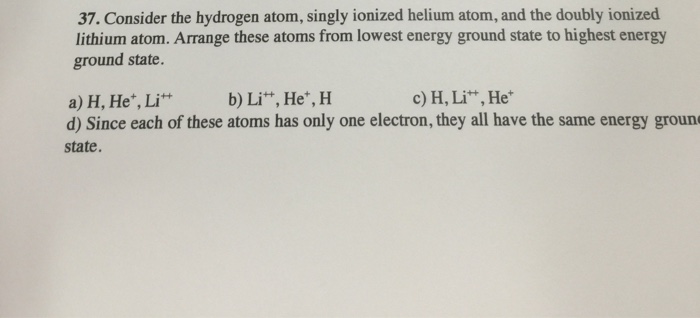Hydrogen-like atoms are those atoms with only one electron remaining, regardless of the number of protons in the nucleus. An example would be singly ionized Helium, which is the lightest hydrogen-like atom, besides hydrogen. Niels Bohr proposed a model of the atom that explained with startling accuracy, the appearance of the spectrum of hydrogen. The value of the first ionization energy (24.6 eV) of helium is much higher than hydrogen (13.6 eV). It is well known that the energy of 13.6 eV is given by applying the Bohr formula, while for the first ionization energy of 24.6 eV of helium so far no one was able to formulate any successful formula. Helium has two electrons in the 1 s orbital. When it becomes singly ionized, forming He +, (A) its spectrum resembles that of the hydrogen spectrum. (B) the remaining electron is easier to remove.
(Pickering Series)
E.C. Pickering discovered ionized helium lines in the hot star Zeta Puppis in 1896, and mistaked it for a form of hydrogen. Later these lines are found in other hot emission line stars and Wolf-Rayet stars. Pickering was convinced that the lines were due to hydrogen under unknown temperature and pressure conditions. What was then called the 'additional hydrogen lines' or the Pickering series could be fitted to the Balmer formula, provided half integral quantum numbers were allowed. Lockyer called the spectrum of ionized helium 'proto-hydrogen'
or the Pickering series could be fitted to the Balmer formula, provided half integral quantum numbers were allowed. Lockyer called the spectrum of ionized helium 'proto-hydrogen'| He II: Energy levels of singly ionized Helium. Pickering series of lines is marked in red. Photoionization thresholds are marked in dashed lines (Series Limits). The five transitions to the ground (n=1) level are not labeled. |
The transitions between the singly ionized helium energy levels corresponding to the Pickering series are 4-5 (10124 Å), 4-7 (5412 Å) and 4-9 (4522 Å) (red in above diagram). Note that the 4-6 (6560 Å) and 4-8 (4859 Å) (green in diagram) transitions were originally not included in this series because they coincided with the hydrogen series of lines and were thus obscured (except in hydrogen deficient stars). Although the 3-4 (4686 Å) (blue in diagram) transition also belongs to ionized helium and often occurs in these hot stars, it did not belong to the pickering series because it has a lower landing level quantum number (n=3 instead of n=4).
In 1912, Pickering still believed it was hydrogen, even when one of Lockyer's pupils, Alfred Fowler showed that these lines are produced in a laboratory mixture of hydrogen and helium. This unusual oversight could partially be attributed to the fact that Fowler still subscribed to Pickering's belief that it was hydrogen. (Just another example that belief is stronger than reason !).
At the turn of the century the physicist Max Planck discovered energy quantization in his theoretical analysis of black body radiation. Albert Einstein later established that these energy quanta are photons or particles of light. Then came Rutherford's model of the atom made up of small massive positively charged nucleus surrounded by a relatively large volume occupied by the negatively charged electrons.
The physicist Niels Bohr, founding father of quantum mechanics, synthesized all these separate facts into a coherent picture of the atom in which the electron orbits were quantized into stationary states and exchange energy with the electromagnetic field in discrete energy packets called photons. His theory predicted the spectrum of singly ionized Helium which corresponded exactly to the Pickering line series. The helium nuclei has twice the charge of the hydrogen nuclei, this gave rise to Pickering's spurious half-integral quantum numbers.
COMMENTARY
This was not the last time that spectral lines at unusual wavelengths were mistaken for hydrogen in strange hypothetical environments; Maarten Schmidt (1963) has also mistaken the emission lines in the spectra of quasars with hydrogen, and this historical error is still not generally recognized.
REFERENCES
- Pickering,E.C.: 1896, Astrophys.J., 4, 369.
- Pickering,E.C.: 1897, Harvard Circ.16.
- Pickering,E.C.: 1897, Harvard Circ.18.
- Lockyer,J.N.: 1900, Inorganic Evolution, Macmillan and Co. (London).
- Pickering,E.C.: 1901, Harvard Circ.55.
- Fowler,A.: 1912, Mon.Not.R.Astron.Soc.73, 62.
- Planck,M.: 1901, Wiedemanns Ann. der Physik, 4, 553.
- Einstein,A.: 1905, Ann. der Physik, 17, 132.
- Rutherford,E.: 1911, Phil.Mag.21 (Ser 6), 669.
- Bohr,N.: 1913, Phil.Mag., 26 (Ser 6), 1.
For a single ionized helium atom ,the longest wavelength in ground state absorb will be?
#(a) 1216xx10^-10m#
#(b)912xx10^-10m#
#(c)304xx10^-10m#
#(d)604xx10^-10m#
1 Answer
Explanation:

A helium atom

That electron would experience no electrostatic repulsion from other atomic electrons (since there were none.) As a result, the nuclei's attraction on that electron would be the only interaction influencing the amount of energy necessary to promote the electron by the minimum extent and hence the longest absorption wavelength possible.
The Rydberg Formula enables the calculation of this absorption wavelength (along with that of any other possible transition) without knowledge of the radius of the electron cloud as long as the following values are available
- The Rydberg Number
#'R'~~1.097 xx 10^7 color(white)(l) m^(-1)# - The atomic number;
#'Z'=2# for helium - The principal quantum number of orbitals the electron occupied before and after the transition of interest. Radiations of long wavelength correspond to those of low energy. The electron currently sits at
#n=1# , a transition to#n=2# allows for the minimum energy change.#n_1=2# and#n_2=1# .#n_1=2# and#n_2=1# .
Helium Charge
Related questions
